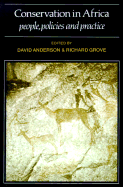Book contents
- Frontmatter
- Contents
- Preface
- List of contributors
- Introduction: The scramble for Eden: past, present and future in African conservation
- Part One Conservation ideologies in Africa
- Part Two Wildlife, Parks and Pastoralist
- Introduction
- 5 Pastoralism, conservation and the overgrazing controversy
- 6 Pastoralists and wildlife: image and reality in Kenya Maasailand
- 7 Integrating parks and pastoralists: some lessons from Amboseli
- 8 The Mursi and National Park development in the Lower Omo Valley
- Part Three Conservation priorities and rural communities
- Part Four Consequences for conservation and development
- Index
6 - Pastoralists and wildlife: image and reality in Kenya Maasailand
Published online by Cambridge University Press: 04 April 2011
- Frontmatter
- Contents
- Preface
- List of contributors
- Introduction: The scramble for Eden: past, present and future in African conservation
- Part One Conservation ideologies in Africa
- Part Two Wildlife, Parks and Pastoralist
- Introduction
- 5 Pastoralism, conservation and the overgrazing controversy
- 6 Pastoralists and wildlife: image and reality in Kenya Maasailand
- 7 Integrating parks and pastoralists: some lessons from Amboseli
- 8 The Mursi and National Park development in the Lower Omo Valley
- Part Three Conservation priorities and rural communities
- Part Four Consequences for conservation and development
- Index
Summary
The transformation of the pastoral and nomadic societies of East Africa has long been perceived as one of the more problematic aspects of the development process. This has given rise to an extensive literature focusing on the ‘development’ of pastoral areas (Monod, 1975; Galaty & Salzman, 1981; Galaty, Aronson, Salzman & Chouinard, 1981; Salzman, 1982). A number of specialised journals (e.g. Nomadic Peoples; Production Pastorale et Société)and informal communication networks (e.g. the Overseas Development Institute's Pastoral Development Network) continue the debate on questions of pastoral ‘development’. However, in East Africa the development of pastoral areas is not simply a matter of integrating the pastoralists into the national economy, because this land can be put to a second use: the creation of reserves and parks for wildlife. This aspect of the development of pastoral areas has received less academic attention despite the fact that National Parks and Game Reserves, with their associated tourist industry, have a very obvious impact on pastoral communities (Western, 1982;Turton, 1984, Chapter 8). The alienation of grazing land for the exclusive use of wildlife and tourists has a very direct impact upon pastoralist communities, giving rise to questions about ‘people versus animals’ in the formulation of African wildlife policy.
- Type
- Chapter
- Information
- Conservation in AfricaPeoples, Policies and Practice, pp. 129 - 148Publisher: Cambridge University PressPrint publication year: 1988
- 1
- Cited by



